User manual
ZTE Grand X View2
Quick Start Guide
(K81)
1
LEGAL INFORMATION
Copyright © 2017 ZTE CORPORATION.
All rights reserved.
No part of this publication may be quoted,
reproduced, translated or used in any form or by
any means, electronic or mechanical, including
photocopying and microfilm, without the prior
written permission of ZTE Corporation.
Notice
ZTE Corporation reserves the right to make
modifications on print errors or update
specifications in this guide without prior notice.
Disclaimer
ZTE Corporation expressly disclaims any liability
for faults and damages caused by unauthorized
modifications of the software.
Images and screenshots used in this guide may
differ from the actual product. Content in this
guide may differ from the actual product or
software.
Trademarks
ZTE and the ZTE logos are trademarks of ZTE
Corporation.
Google and Android are trademarks of Google,
Inc.
The Bluetooth® trademark and logos are owned
by the Bluetooth SIG, Inc. and any use of such
trademarks by ZTE Corporation is under license.

2
microSD Logo is a trademark of SD-3C,
LLC.
Qualcomm® Snapdragon™ processors are
products of Qualcomm Technologies, Inc.
Qualcomm and Snapdragon are trademarks of
Qualcomm Incorporated, registered in the United
States and other countries. Used with permission.
Manufactured under license from Dolby
Laboratories. Dolby, Dolby Audio, and the
double-D symbol are trademarks of Dolby
Laboratories.
Other trademarks and trade names are the
property of their respective owners.
Version No. : R1.0
Edition Time : March 13, 2017
Manual No. :
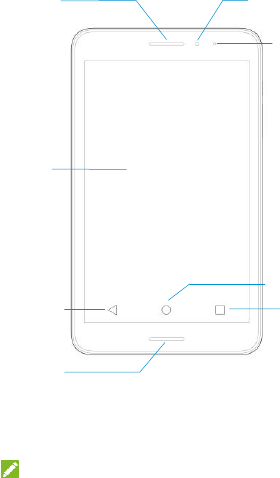
3
Getting to Know Your Device
NOTE:
The positions of the Back key and the Recent
apps key are interchangeable through Settings >
Navigation key.
Front camera
Indicator
Home key
Back key
Touch
Screen
Speaker
Recent
apps key
Speaker
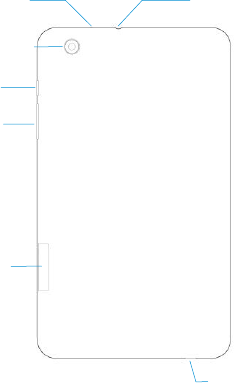
4
Card slot
Volume
buttons
Power
button
Headset jack
Microphon
e
Micro-USB
port
Back camera
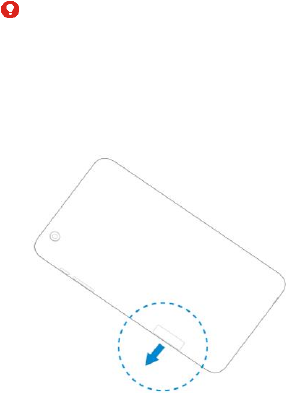
5
Installing the nano-SIM Card
and microSD Card
The nano-SIM card and the microSD card can be
installed or removed while the device is turned on.
You need to unmount the microSD card before
removing it.
WARNING!
To avoid damage to the device, do not use any
non-standard nano-SIM card cut from a SIM card.
You can get a standard nano-SIM card from your
service provider.
1. Insert your fingernail into the corner of the
card slot cover and lift it up gently.
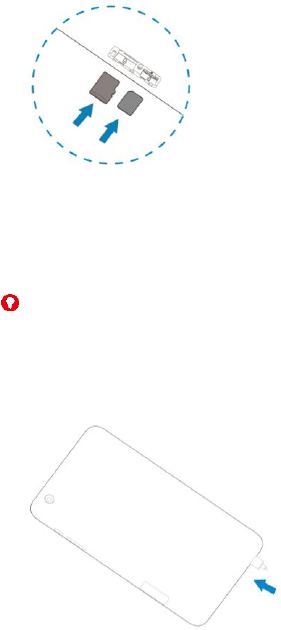
6
2. Hold the nano-SIM card/ microSD card with
the cut corner oriented as shown and slide it
into the card slot.
Charging the Battery
Your device's battery should have enough power
for the device to turn on, find a signal, and make a
few calls. You should fully charge the battery as
soon as possible.
WARNING!
Use only ZTE-approved chargers and cables.
The use of unapproved accessories could
damage your device or cause the battery to
explode.
1. Connect the adapter to the micro-USB port.

7
2. Connect the charger to a standard AC power
outlet.
3. Disconnect the charger when the battery is
fully charged.
CAUTION:
Do not change the built-in rechargeable battery in
your device by yourself. The battery can only be
changed by ZTE or ZTE authorized service
provider.
NOTE:
If the battery is extremely low, you may be unable
to power on the device even when it is being
charged. In this case, try again after charging the
device for at least 20 minutes. Contact the
customer service if you still cannot power on the
device after prolonged charging.
Powering On/Off
Press and hold the Power key to turn on your
device.
To power off, press and hold the Power key
and touch Power off.
NOTE:
If the device freezes or takes too long to respond,
you can press and hold the Power key for about
10 seconds to restart the device.
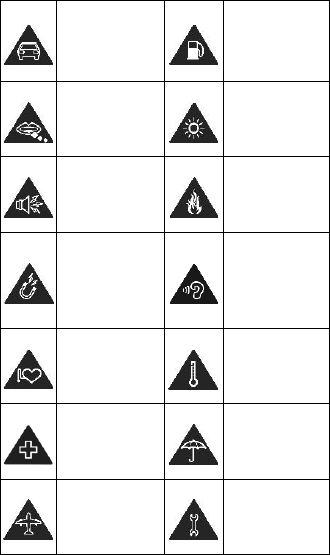
8
For Your Safety
General safety
Don’t make or
receive handheld
calls while
driving. Never
text while driving.
Don’t use at gas
stations.
Small parts may
cause choking.
Your device may
produce a bright
or flashing light.
Your device can
produce a loud
sound.
Don’t dispose of
your device in
fire.
Avoid contact
with anything
magnetic.
To prevent
possible hearing
damage, do not
listen at high
volume levels for
long periods.
Keep away from
pacemakers and
other electronic
medical devices.
Avoid extreme
temperatures.
Turn off when
asked to in
hospitals and
medical facilities.
Avoid contact
with liquids. Keep
your device dry.
Turn off when
told to in aircrafts
and airports.
Do not take your
device apart.
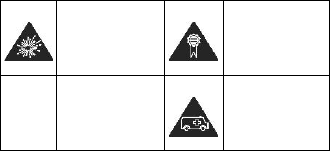
9
Turn off when
near explosive
materials or
liquids.
Only use
approved
accessories.
Don’t rely on your
device for
emergency
communications.
Radio frequency (RF) energy
This device is designed and manufactured not to
exceed the emission limits for exposure to radio
frequency (RF) energy set by the Federal
Communications Commission of the United
States.
During SAR testing, this device is set to transmit
at its highest certified power level in all tested
frequency bands, and placed in positions that
simulate RF exposure in usage near the body.
Although the SAR is determined at the highest
certified power level, the actual SAR level of the
device while operating can be well below the
maximum value. This is because the device is
designed to operate at multiple power levels so
as to use only the power required to reach the
network. In general, the closer you are to a
wireless base station antenna, the lower the
power output.
The exposure standard for wireless devices
employing a unit of measurement is known as the
Specific Absorption Rate, or SAR. The SAR limit
set by the FCC is 1.6 W/kg.
This device is in compliance with SAR for general
population /uncontrolled exposure limits in
ANSI/IEEE C95.1-1992 and had been tested in

10
accordance with the measurement methods and
procedures specified in IEEE1528. This device
has been tested and meets the FCC and IC RF
exposure guidelines when tested with the device
directly contacted to the body.
The FCC has granted an Equipment
Authorization for this device with all reported SAR
levels evaluated as in compliance with the FCC
RF exposure guidelines. SAR information on this
device is on file with the FCC and can be found
under the Display Grant section of
www.fcc.gov/oet/ea/fccid after searching on
FCC ID: SRQ-K81.
For this device, the highest reported SAR value
for usage near the body is 1.18 W/kg.
FCC Regulations
This device complies with part 15 of the FCC
Rules. Operation is subject to the following two
conditions: (1) This device may not cause harmful
interference, and (2) this device must accept any
interference received, including interference that
may cause undesired operation.
This device has been tested and found to comply
with the limits for a Class B digital device,
pursuant to Part 15 of the FCC Rules. These
limits are designed to provide reasonable
protection against harmful interference in a
residential installation. This equipment generates,
uses and can radiate radio frequency energy and,
if not installed and used in accordance with the
instructions, may cause harmful interference to
radio communications. However, there is no
guarantee that interference will not occur in a
particular installation. If this equipment does

11
cause harmful interference to radio or television
reception, which can be determined by turning
the equipment off and on, the user is encouraged
to try to correct the interference by one or more of
the following measures:
Reorient or relocate the receiving antenna.
Increase the separation between the
equipment and receiver.
Connect the equipment into an outlet on a
circuit different from that to which the receiver
is connected.
Consult the dealer or an experienced radio/TV
technician for help.
CAUTION:
Changes or modifications not expressly approved
by the party responsible for compliance could
void the user’s authority to operate the
equipment.
ISED Notice
This device complies with Innovation, Science
and Economic Development
Canada license-exempt RSS standard(s).
Operation is subject to the following two
conditions:
(1) this device may not cause interference, and
(2) this device must accept any interference,
including interference that may cause undesired
operation of the device.
Le présent appareil est conforme aux CNR
Innovation, Sciences et Développement
12
économique Canada applicables aux appareils
radio exempts de licence. L'exploitation est
autorisée aux deux conditions suivantes:
(1) l'appareil ne doit pas produire de brouillage, et
(2) l'utilisateur de l'appareil doit accepter tout
brouillage radioélectrique subi, même si le
brouillage est susceptible d'en
This Class B digital apparatus complies with
Canadian ICES-003.
Cet appareil numérique de la classe B est
conforme à la norme NMB-003 du Canada.
IC: 5200E-K81
ISED Radiation Exposure
Statement
This EUT is compliance with SAR for general
population/uncontrolled exposure limits in
ISED RSS-102 and had been tested in
accordance with the measurement methods
and procedures specified in IEEE 1528 and
IEC 62209. This device and its antenna(s)
must not be co-located or operating in
conjunction with any other antenna or
transmitter.
Cet appareil est conforme aux limites
d'exposition DAS incontrôlée pour la
population générale de la norme CNR-102
13
d'Industrie Canada et a été testé en
conformité avec les méthodes de mesure et
procédures spécifiées dans IEEE 1528 et IEC
62209. Cet appareil et sa ou ses antennes ne
doivent pas être co-localisés ou fonctionner en
conjonction avec tout autre antenne ou
transmetteur.